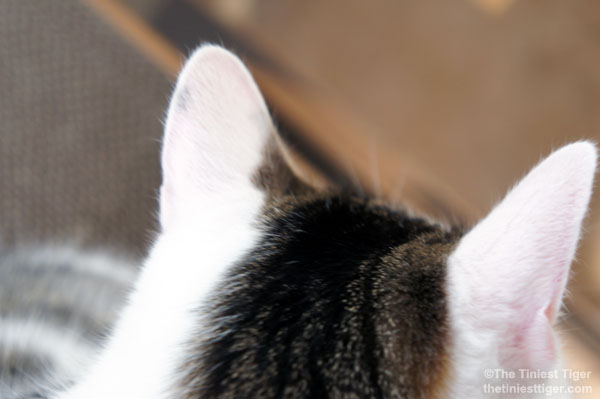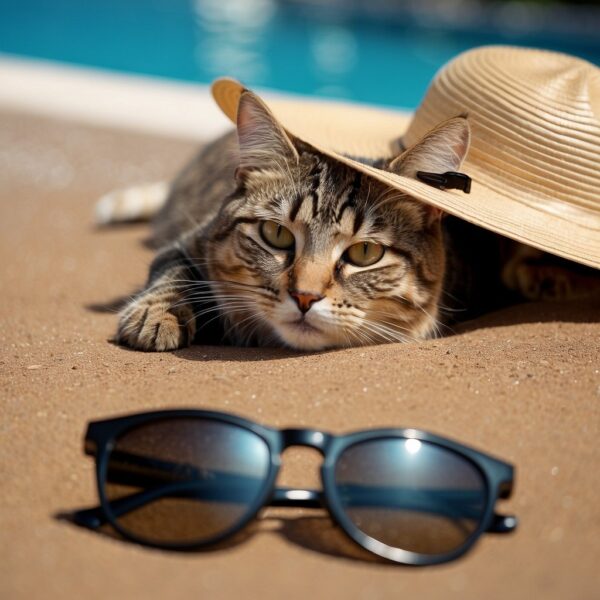
Sunburn in Cats: Cat Sun Safety
Cats can get sunburn. Cats, much like humans, are susceptible to the effects of the sun’s rays, and it might come as a surprise to some that they can indeed get sunburned. Areas of their bodies that lack sufficient fur coverage—primarily their ears, noses, and bellies—are the most vulnerable to sunburn. The condition in cats manifests similarly to how it does in humans, with symptoms that can include red, inflamed, or even scaly and crusty skin. Areas like the eyes and paw pads may also become swollen.
However, not all cats are equally at risk. Those with light-colored or white fur, or hairless breeds, are more likely to experience sunburn. You might not notice the signs right away, as they can be subtle, especially in the initial stages. Guardians need to be vigilant about their cat’s exposure to sunlight, even when they’re staying indoors, as the sun’s UV rays can still reach them through windows. Taking proactive steps to protect them is crucial to prevent the sun’s harmful effects and maintain their skin health.
Key Takeaways
- Cats can indeed get sunburned, particularly on areas with less fur.
- Light-colored and hairless cats are at higher risk for sunburn.
- Preventative measures are important to protect cats from the harmful effects of sun exposure.

Understanding Sunburn in Cats
Sunburn in cats is an often overlooked condition that can lead to serious skin damage, including skin cancer. Genetics, behavior, and physical characteristics can all contribute to a cat’s susceptibility to sunburn.
Characteristics of Feline Skin
Feline skin comprises multiple layers with the outermost being the epidermis. In cats, the epidermal layer is generally thin and can have varying degrees of pigmentation that contribute to sun sensitivity. Cats with white hair or pink skin often have less natural protection against harmful UV rays.
Sunburn Mechanisms in Cats
Cats experience sunburn when their skin cells are damaged by UV rays. Repeated exposure without adequate protection can cause a full thickness burn. Sunburn in cats is essentially the same as in humans, where UV damage leads to skin cell death and inflammation.
Recognizing Sunburn Symptoms in Cats
Symptoms of sunburn in felines include:
- Redness and inflammation of the skin
- Swelling, blisters, or scabs
- Areas of hair loss may appear on the skin Cats may also excessively lick or scratch the affected area, leading to potential skin infections.
Risks of Unprotected Sun Exposure
Prolonged and repeated exposure to the sun can cause chronic skin conditions such as solar dermatitis. In the long term, there is an increased risk of developing skin cancer, specifically squamous cell carcinoma, due to cumulative UV damage.
Genetic Predispositions
Breeds such as Sphynx and other hairless breeds, or those with white fur or light pigmentation, are genetically predisposed to sunburn due to their lack of natural protective fur or pigmentation.
Skin Conditions Related to Sunburn
Sunburn can exacerbate existing skin conditions, and vise versa. Commonly, solar dermatitis in cats is associated with sunburn. This chronic skin condition presents with scaly skin and is typically seen in areas of the body with sparse hair coverage.
Behavioral Contributors to Sunburn Risk
Outdoor cats that enjoy sunbathing or spending long periods in direct sunlight are at greater risk of sunburn. Cats with an established habit of sun-seeking behavior may require additional protection to minimize UV damage.

Preventing Cat Sunburn
Protecting cats from sunburn is essential, particularly for breeds and individuals with features that make them more susceptible. Implementation of protective measures can greatly reduce the risk of sun damage.
Managing Sun Exposure
To prevent sunburn in cats, managing their exposure to sunlight is crucial. During peak sunlight hours, from 10 am to 4 pm, it’s advisable to keep cats indoors. Parents should create shaded areas in the home, using curtains or blinds to block direct sunlight from indoor cats that enjoy lying near windows.
Sun Protection Measures
Cat-safe sunscreens, specifically formulated for feline skin, can be applied to vulnerable areas such as ear tips, nose, and lips. Cat-safe sunscreen should not contain zinc oxide, as it is toxic to cats. Instead, look for products designed to be safe if licked or ingested by cats. Additionally, providing access to plenty of shaded spots in outdoor environments can help prevent sunburn.
Vital Tips for Hairless Cat Breeds
For hairless cat breeds, like Sphynx cats, protection is especially vital since they lack fur to filter out UV rays. These cats benefit from regular application of cat-safe sunscreen, as well as the provision of sun-protected play areas. Guardians of hairless cats should be particularly vigilant about limiting sun exposure.
Educating About Cat-Specific Sun Safety
Education on cat-specific sun safety is key in preventing sunburn in cats. Caretakers should recognize the signs that indicate their cats may be getting too much sun and understand the steps they can take to safeguard their pets. Although preventing sunburn in cats can be a straightforward task with the right knowledge and precautions, it remains an often-overlooked aspect of pet care.

Sunburn Treatment and Care
Cats with sunburn require immediate attention to alleviate pain and prevent further skin damage. Treatment typically involves soothing skin inflammation and caring for any wounds resulting from excessive ultraviolet (UV) exposure.
Immediate At-Home Treatments
At the onset of sunburn, cat parents can provide relief by applying cold compresses to the affected areas. This helps reduce inflammation and discomfort. It’s important not to use ice directly on the skin, but rather to wrap it in a cloth to make a cool compress.
Professional Veterinary Attention
Severe cases of sunburn should prompt a visit to the veterinarian. A vet may prescribe antibiotics to prevent or treat any infections that might occur as a result of damaged skin. Additionally, they can assess for signs of dehydration or more severe complications like the development of a mass or tumor.
Ongoing Care and Monitoring
Cats recovering from sunburn may need ongoing care which includes monitoring for changes in skin condition and ensuring they are kept out of direct sunlight. Regular application of veterinarian-recommended sunscreens can protect vulnerable areas such as ears and nose from future sunburn.
Surgical and Non-Surgical Options
Should sunburn lead to aggressive forms of skin cancer, a veterinarian might refer the cat to an oncologist for evaluation. Surgical removal of tumors may be necessary, while less severe cases may be managed with non-surgical options, such as topical treatments to promote healing of the burns and any secondary wounds.
Recovery and Prognosis
The prognosis for cats with sunburn depends on the severity of the burn and the promptness of treatment. While many cats recover without long-term effects, ongoing protection and monitoring are crucial to prevent recurrence and spot early signs of possible skin cancer.

Behavioral Aspects of Cats with Sunburn
When a cat experiences sunburn, it often leads to noticeable changes in behavior due to discomfort and pain. These behavioral adjustments are important indicators for cat parents to recognize and address the wellbeing of their feline companions.
Discomfort and Pain Responses
Sunburn in cats typically manifests through red, inflamed, or crusted skin which can be hot to the touch. A cat in discomfort will frequently seek relief by adjusting its position or finding cooler locations to rest. In addition to physical symptoms like swollen areas on the nose, paw pads, or ears, watch for signs of agitation or vocalization that indicates pain.
Cats’ Scratching and Licking Behavior
Cats with sunburn may exhibit increased scratching or licking at the affected areas. This behavior, although a natural response to irritation, can aggravate the condition, potentially leading to more severe skin damage. It’s imperative to monitor these behaviors closely and provide appropriate remedies or deterrents to prevent additional harm.
Adapting the Environment for Recovery
Creating a conducive healing environment is vital for a cat with sunburn. Cat parents should ensure their cat has access to:
- Shaded areas to rest and avoid further exposure to sunlight.
- Spaces away from direct sunlight; using curtains or blinds may reduce harmful rays entering through windows.
By facilitating a calm, shaded indoor space, cats are more likely to recover comfortably and reduce the risk of further sun damage.
Comprehensive Sunburn Prevention Strategies
To prevent sunburn in cats, pet owners should be aware of peak sunlight hours, typically from 10am to 4pm, and limit their cat’s exposure during this time. Creating a sun-safe environment involves providing plenty of shaded areas where cats can retreat from the sun’s rays.
Indoor Strategies:
- Close blinds or curtains to block direct sunlight from indoor lounging spots.
- Apply UV protective films on windows where cats like to perch.
- Arrange furniture so that preferred spots are away from intense sunlight.
Outdoor Precautions:
- Ensure access to shaded outdoor spaces, like patios with overhangs or leafy trees.
- Consider using cat-safe sunscreen on vulnerable areas like ear tips and noses. Always consult a vet for recommendations on appropriate products.
Environmental Adjustments:
- Use outdoor shelters or catios that provide protection from direct sunlight.
- Install awnings or umbrellas in outdoor areas to create more shaded spots.
Regular checks for signs of sunburn, such as red or scaly skin, should be part of a cat’s health routine. If a cat exhibits symptoms of sunburn, a veterinary consultation is necessary. By taking these preventive measures, owners can help ensure their feline friends enjoy the sun safely.

Frequently Asked Questions
Sunburn in cats is a genuine concern, especially for cats with light-colored or thin coats. This section addresses common inquiries to ensure that cat owners can recognize and manage sunburn in their feline companions effectively.
What are the signs of sunburn in cats?
The signs of sunburn in cats include redness of the skin, particularly in areas with less fur coverage like the ears, nose, and eyelids. Cats may also experience pain in these areas, along with itching, scratching, and potentially more severe conditions such as skin ulcers or infections.
How can sunburn in cats be treated?
Treatment for feline sunburn typically involves reducing inflammation and discomfort. One might need to administer vet-prescribed pain relief or anti-inflammatory medications. Severe cases may require antibiotic treatment to prevent or address infections.
Are certain cats more susceptible to sunburn?
Yes, certain cats are more susceptible to sunburn. Hairless breeds and cats with light-colored or thin coats are at a higher risk, including breeds like the Sphynx, Bambino, Donskoy, Peterbald, and Lykoi.
What should I do if my cat has been sunburned?
If a cat has been sunburned, they should be moved out of the sun immediately to a shaded or indoor location. Cool compresses can be applied to the affected areas to alleviate discomfort. Consult a veterinarian for specific treatment recommendations.
Is it safe to use sunscreen on cats, and if so, which types?
It is crucial to use only cat-safe sunscreens on cats, as they can ingest harmful chemicals while grooming. Sunscreens for cats should be free of zinc oxide and PABA, both of which can be toxic to cats.
How can I protect my cat from sun exposure and potential sunburn?
To protect cats from sunburn, limit their exposure to the sun during peak hours and provide access to shaded areas. Use cat-safe sunscreen on vulnerable areas of the cat’s skin and consider protective clothing designed for cats, if appropriate. Regular checks for any signs of skin damage are also advisable.